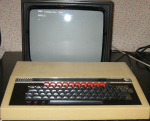|
This computer got its name because in 1980, the BBC decided to start a computer literacy television series. They realized that, with more powerful and increasingly inexpensive microcomputers, it would soon be possible to create them with enough computing power to offer their owners personal hands-on experience with microcomputers at an affordable price.
The BBC considered the NewBrain computer and rejected it. Acorn and Sinclair Research, along with other companies, then submitted designs, and Acorn won.
|

|
Acorn issued two models.
The BBC model A lacked some of the connectors of the Model B (User port, Tube, ...)
The BBC model B was then used almost universally in British schools from its birth into the 90's.
The BBC model B had the same features but had 32 KB RAM (expandable to 64K).
Both models were launched simultaneously the only reason the model A existed was to make the range more accessible to the genral public. The model A was 'stripped down' to save money and sold £100 (in 1982 quite a lot of money) cheaper than the model B (around £400)
The "Tube" was an expansion port which was designed to connect other processors to the BBC (6502, Z80, 68000 or ARM 1 RISC). Interface cards were specially designed for the tube. For instance another 6502 with 64K of RAM or a Z80 cpu also with 64K of RAM and CP/M 2.2 as operating system.
One of its most popular peripherals was the "Torch" floppy disk unit, a 5.25" floppy disk drive with a Z80 which allowed the BBC to use CP/M software.
In 1985, the Acorn BBC Model B+ was released. The Model B+ had new features : 64K of RAM instead of 32 KB and internal circuitry for the Econet and Disk Drive as standard (both available as an upgrade in the models A and B). The later models included disk support as standard, using either an 8271 or a 1770 disk controller.
It was then followed by the BBC Master.
Note:
The early prototypes of the BBC machine were based on the earlier acorn system 1 boards, its modular rackmounted expansion system meant that the prototyping for the BBC range could occur. In fact in the early episodes of 'The computer programme' the BBC computer literacy project tv show, the BBC micro on the desk was just an empty case with the keyboard connected to an Acorn system 3 under the desk as it took longer than expected to compress the large amounts of TTL logic in the original prototypes into the LSI ULA unit that sat in the BBC micro.
|